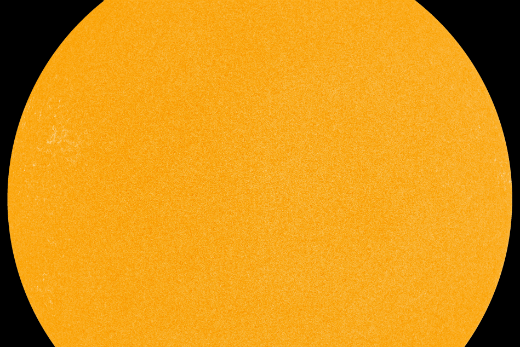Scientists are in conflict over the appearance of the sun-spotless sun this week. Sun spots are credited with causing solar flares, radiation storms and geomagnetic storms here on Earth, causing phenomena such as the Aurora Australis (southern lights) and aurora borealis (northern lights).
The sun without spots. Image: SDO/HMI
The numbers of sunspots vary over an eleven year cycle, with the theory being that the more sunsports there are, the more flares there are. The greatest number of sunspots in any given solar cycle is the solar maximum. The lowest number is solar minimum.
According to NASA, "during Solar Max, huge sunspots and intense solar flares are a daily occurrence. Auroras appear in Florida. Radiation storms knock out satellites. Radio blackouts frustrate CB radio as well. The last such episode took place in the years around 2000-2001.
"During solar minimum, the opposite occurs. Solar flares are almost non-existent while whole weeks go by without a single, tiny sunspot to break the monotony of the blank sun. This is what we are experiencing now."
On July 28 and 29 there were no sunspots, no solar flares, and no CMEs, according to the spaceweather website, which goes on to say that even without visible sun spots, the Aurora Australis appeared in force over the frozen Antarctic continent.
'What caused the display? We don't know. Sometimes space weather just happens,” says the site's admin.
History shows there can still be big events during weak solar cycles. In 1859, during a low point in the solar cycle, the "Carrington Event" prompted geomagnetic storms as far south as the Caribbean. Another event of that magnitude could hugely disrupt lives on the planet today, downing electrical grids, the internet and jamming satellite communications.
The Suspicious Observers website points to a plasma filament north of the coronal hole currently crossing the earth facing side of the sun as being a source of possible solar eruptions.
The coronal hole is visible at 193 angstroms, and will be the source of the next stream of charged particles from the solar wind.
The plasma filament showed a surge on Wednesday which could mean it is becoming active.
Such filaments are monitored because they can produce the types of solar eruptions and inter planetary shockwaves that the solar observing community likes to track across the solar system.
Unlike a solar flare filaments often release without the X ray warning, letting loose planets worth of material that can trigger technological, atmospheric and even human health effects.



1 comment
Good view
Posted on 01-07-2016 08:21 | By Gigilo
Suspicious Observers reports every night what I find more interesting and closer to home is the global weather patterns and earthquake watch in the same reports. Well worth your investment of five minutes.
Leave a Comment
You must be logged in to make a comment.